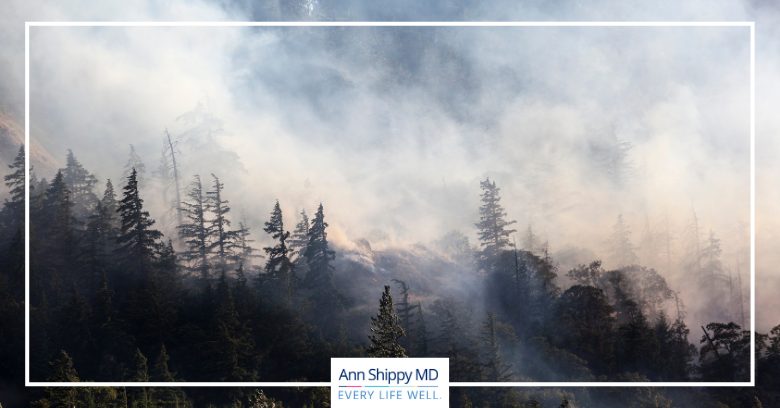Forest Fires And Your Health
As I write this, there are over 500 forest fires on the west coast and many towns and cities are experiencing extremely unhealthy and hazardous air quality.
The AQI – Air Quality Index – for Portland and Seattle are over 200 right now and San Francisco and parts of central and southern Oregon, levels are over 300 as I type.
What do these levels mean? And what is the impact that forest fires have on our health as we breathe in unhealthy air? These are the questions that I’m going to answer in today’s article because it is an important, and an extremely timely, topic.
I was recently in Santa Fe and experienced poor air quality from the fires burning in New Mexico. A couple of years ago I was in Lake Tahoe when fires were burning in Yosemite.
It is quite the experience to step outside when you feel like you can’t breathe and have to stay inside. This is even more impactful when many people are already feeling constricted now as they work from home, distance learn and social distance.
I often talk about the dangers of breathing indoor air contaminated with mold, flame retardants, cleaning agents and other indoor air pollutants, but what do we do when the air outside is worse and we can’t open the windows?
Keep reading to learn more about:
- How forest fires affect air quality
- Particulate matter and how they affect your health
- How to understand the Air Quality Index
- Steps you can take to protect yourself from the negative health effects of wildfire pollution
Forest Fires And Air Quality
Forest fires create smoke, which is a mixture of gasses and fine particles from burning trees, buildings, cars and other materials in the fire’s path. When it comes to air quality and health issues of forest fires, it becomes important to understand the particles.
There are large particles in the air, called PM-10 or particulate matter 10, that you can see. These include smoke, soot, dust, dirt and drops of liquids. These particles irritate the eyes, nose and throat.
Think about driving down a dusty road, tilling dry soil or mining activities. The dust and other particles produced are typically big enough for you to see and feel on your skin.
There are also smaller particles, called PM 2.5 or particulate matter 2.5 that are composed of everything from sulfates, nitrates and heavy metals to combustion byproducts including hydrocarbons. These fine particles are often bound to toxins in the air. Because of their size – 2.5 micrometers or less – PM 2.5 easily get into the lungs and then can pass into the body. They are so small that they enter your circulation.
You may not be able to see the individual PM 2.5 particles, but when there are a lot of them, you’ll see a haze cover the sky, like the orange haze and poor visibility we’ve seen across the west coast in the last week.
PM 2.5 stays in the air for a long time and travels long distances with winds. This is why even if you are far from a forest fire you may be exposed to unhealthy air.
As these small particles enter the body, the body detects the foreign matter and mounts an immune response. From this perspective, it is important to consider air pollution as a root cause of inflammation in the body, contributing to a host of health issues.
PM 2.5 And Your Health
Small particulate matter in the air is estimated to contribute to millions of premature deaths each year.
Exposures to PM 2.5 correlate with:
- Attention deficit hyperactivity disorder (ADHD)
- Autism Spectrum Disorder (ASD)
- Loss of cognitive function
- Asthma
- Allergies
- Chronic obstructive pulmonary disease (COPD)
- High blood pressure
- Stroke
- Lung cancer
- Heart disease
The research makes clear links between chronic disease and respiratory inflammation in adults, but what is particularly concerning is that PM 2.5 exposure also affects children before they are born.
One study showed that a mother’s exposure to PM 2.5 during pregnancy affected the vascularization of the placenta, and therefore the ability of nutrients and oxygen to pass from mother to baby. High exposures of PM 2.5, especially in the 8th and 9th months of pregnancy are associated with low term birth weights. And, gestational exposure also increases the baby’s risk of developing asthma.
As babies and young children don’t have the detoxification capacity of adults, they are at greater risk for health effects as a result of PM 2.5 exposures. Older adults, pregnant women and people with heart disease or lung disease are also at increased risk.
Likely long-term exposures to air pollution carry the greatest risks, but I can’t discount the short-term exposures to forest fire smoke, especially for those most vulnerable. When we take into account all of the other toxins and chemicals in the environment, we need to do everything we can to limit the exposures that we can control.
Understanding the Air Quality Index
The first step, as always is awareness. Once you are aware of the issues with air quality and how to monitor air quality in your city or the places you travel to, you become more empowered to limit exposures to unhealthy outdoor air.
The Air Quality Index (AQI) is an index used to rate air quality and takes into account particulate matter along with other pollutants including ozone, carbon monoxide, sulfur dioxide and nitrogen dioxide.
You can look up real time reports for your zip code using the government’s Air Now website or a variety of popular smartphone apps, such as AirVisual. Consider checking your air quality like you check the weather.
Here is a breakdown of the different categories within the AQI:
- 0 – 50: Good air quality; little to no risk of air pollution.
- 51 – 100: Moderate air quality; air quality is acceptable, but there may be a risk for those who are particularly sensitive.
- 101 – 150: Unhealthy for sensitive groups; young children, older adults, pregnant women and those with poor health may experience health effects from air pollution.
- 151 – 200: Unhealthy air quality; members of the general public may experience health effects and sensitive groups may experience more severe effects.
- 201 – 300: Very unhealthy air quality: the risks of health effects are increased for everyone. This is a health warning.
- 301 and higher: Hazardous: everyone is likely to be affected. This is a health warning of emergency conditions.
Currently, we are experiencing very unhealthy and hazardous conditions across the west. Since air quality changes quickly along with the wind and weather, it’s helpful to monitor your area frequently.
Protective Strategies
In addition to being aware of the air quality in your community, there are many other things you can do to protect yourself and your family from the negative effects of wildfire smoke and poor air quality.
1. Use the AQI as a guide for outdoor activity and exercise. When air quality is good, that is the perfect time to get outside for a run or bike ride. When it is moderate, you might consider less strenuous activities, like walking or gardening, where you don’t breathe as hard. When air quality is unhealthy or hazardous, this is the time to stay indoors. If there are fires, leave the area if possible.
2. Wear a mask. We are all used to wearing masks these days because of COVID-19, however, paper or fabric dust masks aren’t enough to protect you from PM 2.5. You’ll need an N-95 mask or equivalent if you need to go outside in very unhealthy or hazardous air quality from forest fires.
3. Use and indoor air purifier. A HEPA air filter is a must have for indoor air quality and equally important when forest fires are close. When outdoor air is poor, it certainly affects indoor air, so in addition to keeping your windows closed, you’ll want to filter the air in your living space. My go-to suggestions for air filters are IQ Air HealthPro and Austin Air Allergy Machines. Both of these I personally use and they both filter out small particulate matter.
4. Support detoxification. It’s inevitable that some particulates – and toxins – will make their way into our body, which is why having well-functioning detoxification pathways is important. You can read more about the importance of detoxification and how to detoxify in my recent article.
Since a forest fire might happen suddenly without warning, it will be helpful to have health strategies such as a Paleo diet already in place to provide protection and the foundation of detoxification. Think about including antioxidant rich, colorful foods every day including green tea, turmeric, berries, cruciferous vegetables, and others.
In addition, consider upping important detoxification support during this time including liposomal glutathione, liposomal vitamin C, immune support and mitochondrial support.
5. Consider the root cause. When it comes to health from a Functional Medicine perspective, I’m always asking why to uncover the root cause. When it comes to forest fires and the hot, dry conditions that create and spread them, I can’t overlook climate change as an answer to why this is happening. While there is much we can do on the individual level to protect our health, we need bigger systemic change to protect our communities and our earth from the destruction that we’ve recently experienced on the west coast.
While there is a lot going on these days that may seem overwhelming, remember that information can help you know the next important steps to take…. And that you can make tremendous progress over time by taking incremental steps.
If you aren’t already, my hope is that you will begin checking the air quality to learn more about the environment you live in and how it is affecting your health and symptoms. My heart and thoughts go out to all of you affected by forest fires.
References
- https://www.cdc.gov/air/particulate_matter.html
- https://pubmed.ncbi.nlm.nih.gov/29334526/
- https://pubmed.ncbi.nlm.nih.gov/25454230/
- https://pubmed.ncbi.nlm.nih.gov/17255799/
- https://pubmed.ncbi.nlm.nih.gov/29446596/
- https://pubmed.ncbi.nlm.nih.gov/30772544/
- https://pubmed.ncbi.nlm.nih.gov/29097084/
- https://pubmed.ncbi.nlm.nih.gov/30959062/
- https://www.epa.gov/pm-pollution/how-smoke-fires-can-affect-your-health













